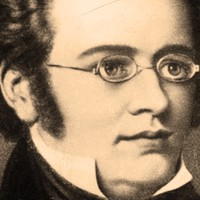Mozart’s Gran Partita

Sponsored By
- May 29, 2015

- May 31, 2015


Sponsored By



By the time Schubert turned twenty, in 1817, he had already composed some 300 Lieder (half of his lifetime output) and was in peak form as a songwriter. In a standout song from that year, “Die Forelle” [“The Trout”], cascading piano figurations evoke a babbling brook from the first notes. In a later stanza, minor-key music and thicker textures capture the muddied waters and the spectator’s “raging blood” at seeing the fish hooked. With its earworm of a melody and an uncanny sense of drama for such a simple little tale, it is no wonder that “The Trout” has always been among Schubert’s most popular Lieder.
Schubert had occasion to revisit “The Trout” in 1819. While traveling in upper Austria that summer, he met Sylvester Paumgartner, a friend-of-a-friend and an amateur cellist, who asked for a new quintet. Paumgartner specified the instrumentation of violin, viola, cello, double bass, and piano, a format favored by Hummel and other composers before Schubert. (The more familiar quintet of two violins, viola, cello, and piano caught on later, starting with Schumann.) Paumgartner specifically requested a theme and variations movement based on The Trout, a sign of the song’s instant appeal.
The “Trout” Quintet offers many pleasures besides the movement that furnishes its nickname. The opening movement plays with a rising arpeggio gesture that interjects and comments around the singing themes, setting up the same kind of active discourse between melody and accompaniment found in Schubert’s songs. (The rising arpeggios also foreshadow the “Trout” music still to come.) The Andante movement makes exquisite use of the quintet’s available textures, including tender duets for viola and cello, surrounded by a multi-layered accompaniment. The scoring stands out in the Scherzo as well, in which the heft of the double bass makes the speedy music all the more muscular.
To begin the “Trout” movement, the strings outline the theme in a simple Andantino treatment, and then the variations commence with the piano issuing a decorated version of the theme in octaves, surrounded by flowing string accompaniment. The variations build in complexity and also venture into the minor key, until the closing variation finally returns to the characteristic rising and falling accompaniment figure that defines the song’s fluid state. After the hilarity of the variations, the quintet closes with a mild-mannered finale. More rising arpeggios give the impression that the babbling brook of the preceding movement has not quite run dry.
Aaron Grad ©2014

After Mozart moved to Vienna in 1781 to try his luck as a freelancer, he was eager to catch the ear of Emperor Joseph II and those in his court. One trend Mozart picked up on was the interest in harmoniemusik, or music for small wind ensembles. The Emperor had recently added such a group to his retinue, the kind of band that was perfect for entertaining at outdoor gatherings, where its sound carried well on the open air. In earlier years, the usual configuration included pairs of oboes, bassoons, and horns; Mozart wrote a number of Divertimentos for that ensemble during his youth in Salzburg. The Emperor’s group added a pair of clarinets, and so Mozart introduced those instruments in two Serenades composed in his first years in Vienna.
The Serenade in B-flat (K. 361) known as the “Gran Partita” was an extension of that harmoniemusik tradition. The exact origins remain clouded; Mozart may have composed it as early as the end of 1781, or perhaps not until the beginning of 1784. The instrumentation expanded upon the basic harmonie setup, adding to it a pair of basset horns (the tenors of the clarinet family), a second pair of horns, and a contrabass (or contrabassoon). Besides its hefty instrumentation, the Serenade’s seven sophisticated movements and length approaching an hour far exceeded the typical standards for Serenades, which other composers treated essentially as disposable background music.
One theory (albeit one light on supporting evidence) is that Mozart composed this Serenade as a wedding present to his wife in 1782. Another idea is that he wrote it for his friend Anton Stadler, the clarinetist for whom he went on to create a Clarinet Quintet and a Clarinet Concerto. We do know that Stadler led an ensemble in a performance of four of the seven movements in March of 1784, although analysis of the manuscript paper suggests that it was composed earlier. Amid the lack of hard facts, the work has taken on a mythical significance thanks to its appearance in the play and subsequent film Amadeus; it is the music playing in an ornate salon, conducted by the boorish young Mozart, which leads Salieri to declare, “It seemed to me that I was hearing the voice of God.”
The Serenade’s nickname of “Gran Partita” is another sticky point. Even though it was added to the manuscript in a hand other than Mozart’s, it is a fitting moniker for such a grand suite of music, and so it has stuck as the name by which most fans know this singular score.
The “Gran Partita” begins with a stately introduction in a Largo tempo, with the principal clarinet taking the lead, along with melodic support from the first oboe. The Allegro molto body of the movement announces its main theme with only a subdued quartet of clarinets and bassoons, but just four measures later the entire ensemble enters with the full force of a forte dynamic. These extremes of dynamics and articulation spar throughout the movement, giving the music a symphonic breadth of sound.
The first of two Menuetto movements is a particularly hearty specimen, incorporating two different contrasting trio sections, including one full of minor-key drama and stirring horn calls. This palate-cleansing dance prepares the emotional core of the Serenade, the Adagio. (This is the music in that Amadeus scene.) The melodic exchanges among the oboe, clarinet, and basset horn play like a tender scene out of an opera.
Another Menuetto lightens the mood—even with the inclusion of another minor-key trio—and then a slow movement labeled Romanze offers more songlike melodies, only disturbing the calm for a contrasting middle section driven forward by a pecking bassoon accompaniment. The penultimate movement is a cheerful Theme and Variations, reusing music that Mozart originally composed for a Flute Quartet in Salzburg. The Rondo that concludes this monumental Serenade delivers as much energy and punch as any symphonic finale, especially once everyone ratchets up to the fortissimo dynamic at the end.
Aaron Grad ©2014
Get driving directions and find nearby parking.
Find dining options close to the venue.
View seating charts to find out where you'll be seating.
Get driving directions and find nearby parking.
Find dining options close to the venue.
View seating charts to find out where you'll be seating.
